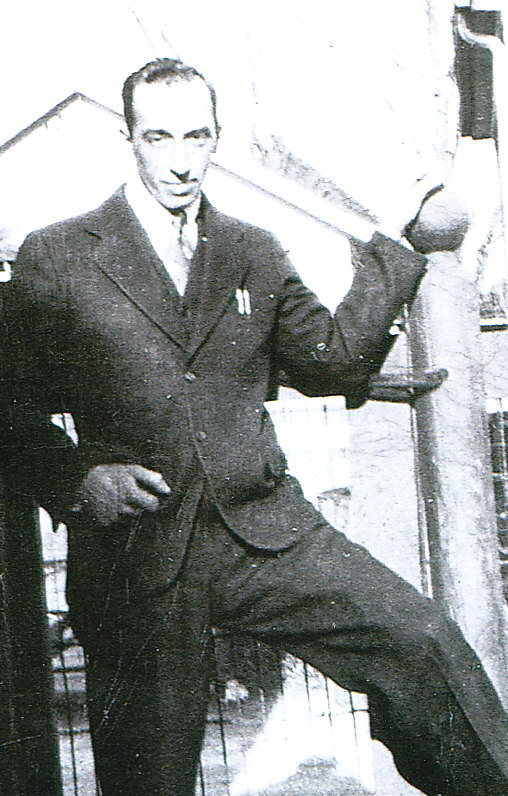Home > Family History > DeMarc > Lou DeMarc
|
Luigi ďLouĒ DeMarc (given as Lou Paul DeMarc at times) was born in the small town of West Pittsburg, Lawrence County, Pennsylvania, on Thursday, October 30, 1913. He was the fifth child born to Charles DeMarc and Mary (DeMatteo) DeMarc, both of whom immigrated to the United States in the early 1900ís from southern Italy. Lou, who spoke both English and Italian, grew up in West Pittsburg and attended the West Pittsburg Public School. During the 1925-1926 school term Lou was in the sixth grade and had Ms. Allurah Leslie as his teacher. Among his classmates was his older brother Ralph. Lou would have graduated from the eighth grade in June 1928, and probably did not attend high school. All the DeMarc boys had nicknames and Lou was known as ďAce.Ē He was very close to his father and to his younger brothers George and Charlie. He was a popular boy growing up and the favorite son of his father Charles. Louís older sister Josephine got married to Anthony ďTonyĒ Marinelli in the late 1920ís, moved to Detroit, Michigan, and started her own family. Several of the DeMarcís, including Lou, George, Pete, and Mike later followed Josephine out to Detroit by the early 1940ís. Tony Marinelli was working for the Ford Motor Company Ė most likely at the Highland Park plant - and was able to get them all hired there as well. Lou and George lived with Josephine and her family. Lou also bought a 1941 Ford, the last year that the auto factories made cars for the public as they switched to wartime production. American neutrality was ended on December 7, 1941, when Japanese forces attacked the American naval and air fortress at Pearl Harbor, Hawaii. Before too long brothers Lou, Mike, George, and Charlie would all be called upon to serve their country. Lou, while living in Detroit, was inducted into the U.S. Army on June 20, 1942, with a service number of 36-507-077. After initial training he joined what became the 540th Combat Engineer Regiment, a unit responsible for performing a variety of engineering tasks to support combat operations. The regiment underwent specialized amphibious training at Camp Bradford (now Little Creek), Virginia, before reporting to Camp Kilner, New Jersey, in mid-October 1942 for overseas assignment. The 540th would soon distinguish itself in combat. The 540th took part in Operation TORCH, the invasion of Vichy French-controlled northwest Africa in November 1942. The unit was assigned to the Western Task Force, and made an amphibious assault with other American units at the small port of Safi 150 miles south of Casablanca on the morning of November 8. Without any covering fire the American invaders had a hell of time getting off the beach as French snipers pinned them down. After a three-day battle the port and surrounding area was secured and the bulk of the American forces sped north to assist in the struggle for Casablanca. The 540th spent the next few months in Morocco (and in Algeria and Tunisia) building bridges and roads, improving port facilities, unloading supply ships, and constructing field hospitals and Prisoner-of-War (POW) camps. Next up was Operation HUSKY, the Allied invasion of Sicily that took place on July 9, 1943. The regiment, often engaged in combat, performed admirably during U.S. Army Lt. Gen. George S. Pattonís race to trap the German and Italian defenders at Messina. The Allies soon made the leap to the Italian Peninsula and the 540th was landed at Salerno on September 9, 1943, as part of Operation AVALANCHE. The regiment quickly moved to nearby Naples, and concentrated on clearing mines and other obstructions and repairing the port facilities demolished by the Germans. In the midst of the action Lou found himself near the birthplace of his parents. After Naples the 540th took part in the amphibious operation at Anzio in January 1944, battled through Cassino in May 1944, and participated in the high-profile capture of Rome in June 1944. Next up was France. On August 15, 1944, the 540th was landed with the U.S. 36th Infantry Division in the Saint Raphael-Frejus area of southern France as part of Operation DRAGOON. The operation was in support of the ongoing Allied breakout at Normandy in northern France, where Louís brother George was engaged in combat. The engineers took a beating clearing the beaches around Saint Raphael the first few days. Five days after the landing, on August 20, Lou unfortunately died after being wounded in action. The exact circumstances of his death are unknown, but I believe he was wounded on August 18 when a bulldozer, clearing some obstructions on a roadway, struck a German-made anti-tank teller mine. In that incident two engineers were killed, two were mortally wounded, and a handful more were wounded. Lou was thirty years old and was most likely buried at the Rhone American Cemetery at nearby Draguignan. A telegram from the War Department notified the DeMarc family of Louís death. Charles DeMarc Sr. was devastated by his favorite sonís death and took it particularly hard. He grew depressed, suffered a heart attack, and his health slowly declined. He was bedridden for most of the next few years and passed away on May 21, 1947. The official cause of death was ďCardiac Arrest,Ē but everyone knew he died of a broken heart. Charles was buried in St. Vitus Catholic Cemetery in Shenango Township near New Castle. After the war the U.S. military began the tasking of repatriating the remains of those servicemen killed in action for permanent burial back in the United States. Louís remains were exhumed in late 1948 and placed aboard the U.S. Army transport Lt. James E. Robinson for return to New York Harbor. From New York the remains were probably transported by train to New Castle. His remains arrived at the DeCarbo Funeral Home on Tuesday, January 18, 1949, and a viewing was held that afternoon beginning at 2:00pm. The next morning at 9:00am a mass, conducted by the Reverend Nicholas DeMita, was held at the St. Vitus Catholic Church in New Castle. Members of the New Castle Catholic War Veterans served as Louís pall bearers. Afterwards, as a solemn crowd looked on, he was finally reunited with his father at the St. Vitus Cemetery. Lou was interred in a plot, originally planned for his mother Mary, right next to his dear father. The two even share the same headstone.
|











